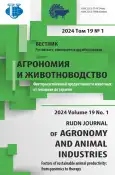Оценка биологической эффективности инсектицидов в контроле численности грушевой медяницы
- Авторы: Подгорная М.Е.1, Диденко Н.А.1, Прах С.В.1, Васильченко А.В.1
-
Учреждения:
- ФГБНУ «Северо-Кавказский федеральный научный центр садоводства, виноградарства, виноделия»
- Выпуск: Том 19, № 1 (2024): Факторы устойчивой продуктивности животных: от геномики до терапии
- Страницы: 128-138
- Раздел: Защита растений
- URL: https://journal-vniispk.ru/2312-797X/article/view/315834
- DOI: https://doi.org/10.22363/2312-797X-2024-19-1-128-138
- EDN: https://elibrary.ru/AHYHPT
- ID: 315834
Цитировать
Полный текст
Аннотация
Psylla pyri L., или грушевая медяница, — доминирующий вредитель груши, ущерб от вредоносности которой может достигать 70…90 %. Это поливольтинный вредитель, за один вегетационный сезон на юге России может развиваться до 5–7 поколений, накладывающихся одно на другое. Фитофага трудно контролировать из-за развития устойчивости к применяемым инсектицидам, присутствия одновременно всех фаз развития в летний период, поэтому целью исследований стало выявление наиболее эффективных инсектицидов различного механизма действия, сдерживающих численность и развитие нимф P. pyri L. В задачи исследования входило уточнение биологических особенностей развития обыкновенной грушевой медяницы и определение эффективности инсектицидов различного механизма действия в контроле численности P. pyri L. Представлены результаты исследований по динамике развития грушевой медяницы в Прикубанской зоне Краснодарского края. В годы исследований отмечена сумма эффективных температур, необходимая: для начала яйцекладки — 40 °C (при пороге 6 °C), начала отрождения личинок — 121…122 °C, периода от яйца до появившегося имаго — 300 °C. Мониторинг за динамикой развития фитофага показал, что вредитель в течение вегетационного сезона развивается в 6 полных поколениях. Показаны результаты мелкоделяночных полевых опытов по определению биологической эффективности инсектицидов, проведенных в 2021–2022 гг. в Прикубанской зоне, центральной подзоне садоводства Краснодарского края на базе генетической коллекции центра коллективного пользования (ЦКП) Северо-Кавказского федерального научного центра садоводства, виноградарства, виноделия на груше сорта Левен. Выявлено, что применение препаратов на основе ювеноидов и ингибиторов синтеза хитина не уступают по эффективности химическим инсектицидам. Проведенные в течение двух лет исследования показали, что максимальная эффективность после однократного применения препаратов Акарб, ВДГ (250 г/кг феноксикарб) и Димилин, ВДГ (800 г/кг дифлубензурон) была на 10-е сутки и составляла 83,3…91,7 %, что выше эффективности стандарта.
Ключевые слова
Об авторах
Марина Ефимовна Подгорная
ФГБНУ «Северо-Кавказский федеральный научный центр садоводства, виноградарства, виноделия»
Email: podgornayame@mail.ru
ORCID iD: 0000-0002-2268-1279
SPIN-код: 6686-9037
кандидат биологических наук, заведующая лабораторией защиты и токсикологического мониторинга многолетних агроценозов
Российская Федерация, г. Краснодар, ул. им. 40-летия Победы, д. 39Надежда Александровна Диденко
ФГБНУ «Северо-Кавказский федеральный научный центр садоводства, виноградарства, виноделия»
Автор, ответственный за переписку.
Email: didenko-n.a@mail.ru
ORCID iD: 0000-0003-4012-4457
SPIN-код: 2418-6797
младший научный сотрудник лаборатории защиты и токсикологического мониторинга многолетних агроценозов
Российская Федерация, г. Краснодар, ул. им. 40-летия Победы, д. 39Светлана Владимировна Прах
ФГБНУ «Северо-Кавказский федеральный научный центр садоводства, виноградарства, виноделия»
Email: sp41219778@yandex.ru
ORCID iD: 0000-0001-6416-3798
SPIN-код: 3652-3020
кандидат биологических наук, старший научный сотрудник лаборатории защиты и токсикологического мониторинга многолетних агроценозов
Российская Федерация, г. Краснодар, ул. им. 40-летия Победы, д. 39Анфиса Витальевна Васильченко
ФГБНУ «Северо-Кавказский федеральный научный центр садоводства, виноградарства, виноделия»
Email: anfisavv@yandex.ru
ORCID iD: 0000-0001-7680-7511
SPIN-код: 6853-1941
младший научный сотрудник лаборатории защиты и токсикологического мониторинга многолетних агроценозов
Российская Федерация, г. Краснодар, ул. им. 40-летия Победы, д. 39Список литературы
- Bozkurt V, Ugur A. Effects of kaolin on some biological properties of pear sucker [Cacopsylla pyri (L.) (Hemiptera: Psyllidae)]. Acta Hortic. 2020;1269:191–198. doi: 10.17660/ActaHortic.2020.1269.26
- Balykina EB, Korzh DA, Yagodinskaya LP. Psylla pyri seasonal population changes in the Crimea. Plant protection news. 2015;(3):34–38. (In Russ.).
- František K, Stará J. Management and control of insecticide-resistant pear psylla (Cacopsylla pyri). Journal of Fruit and Ornamental Plant Research. 2006;14(3):167–174.
- Civolani S. The past and present of pear protection against the pear psylla, Cacopsylla pyri L. In: Perveen F (ed.) Insecticides: Pest Engineering. 2012. p.385–408.
- Gajski D, Pekar S. Assessment of the biocontrol potential of natural enemies against psyllid populations in a pear tree orchard during spring. Pest Management Science. 2021;155:104390. doi: 10.1002/ps.6262
- DuPont ST, Strohm C, Nottingham L, Rendon D. Evaluation of an integrated pest management program for central Washington pear orchards. Biological Control. 2021;152:104390. doi: 10.1016/j.biocontrol.2020.104390
- Ahmad MJ, Mohiudin S, Pathania SS, Mukhtar M. Feeding potential of anthocorid bug, Blaptostethus pallescens (Poppius) (Hemiptera: Anthocoridae) against eggs of pear psylla, Cacopsylla pyricola (Foerster) (Homoptera: Psyllidae) on pear in Kashmir. Journal of Entomology and Zoology Studies. 2020;8(5):685–689.
- Petrakova L, Michalko R, Loverre P, Sentenská L, Korenko S, et al. Intraguild predation among spiders and their effect on the pear psylla during winter. Agriculture, Ecosystems & Environment. 2016;233:67–74. doi: 10.1016/j.agee.2016.08.008
- Erler F, Tosun HS. Plant oils as oviposition deterrents against winterform females of pear psylla, Cacopsylla pyri (L.) (Hemiptera: Psyllidae). Phytoparasitica. 2017;45:509–515. doi: 10.1007/s12600‑017‑0609‑7
- Li J, Tian B. Peppermint essential oil toxicity to the pear psylla (Hemiptera: Psyllidae) and potential applications in the field. Journal of Economic Entomology. 2020;113(3):1307–1314. doi: 10.1093/jee/toaa009
- Didenko NA, Podgornaya ME. Biological approaches to the development of integrated protection of pear plants from pear psylla. Fruit growing and viticulture of South Russia. 2021;(70):254–268. (In Russ.). doi: 10.30679/2219‑5335‑2021‑4‑70‑254‑268
- Koltun NE, Grebneva YN. Control of pear psylla number and its harmfulness in the orchards of Belarus. Proceedings of the National Academy of Sciences of Belarus. Agrarian series. 2014;(4):66–74. (In Russ.).
- Skrylev AA, Kashirskaya NY. The use of modern insecticides of different mechanisms of action against pear psylla according to the growing season. Fruit growing and viticulture of South Russia. 2016;(40):137–145. (In Russ.).
- Balykina EB, Korzh DA, Gorina VM, Yagodinskaya LP. Comparative effectiveness of various protection systems of the pear from Psilla pyri L. in the Crimea. Acta Horticulturae. 2020;1298:469–475. doi: 10.17660/ActaHortic.2020.1298.64
- Civolani S, Soroker V, Cooper WR, Horton DR. Diversity, biology, and management of the pear psyllids: a global look. Annals of the Entomological Society of America. 2023;116(6):331–357. doi: 10.1093/aesa/saad025
Дополнительные файлы










